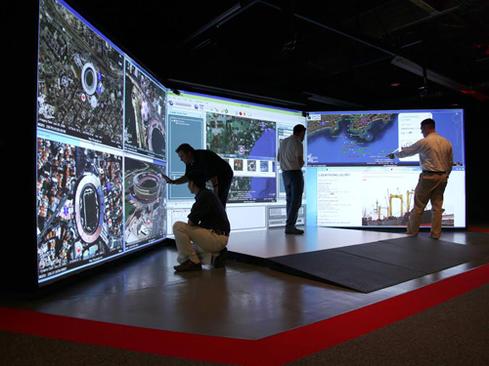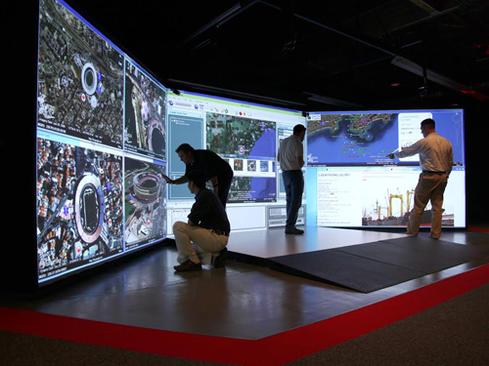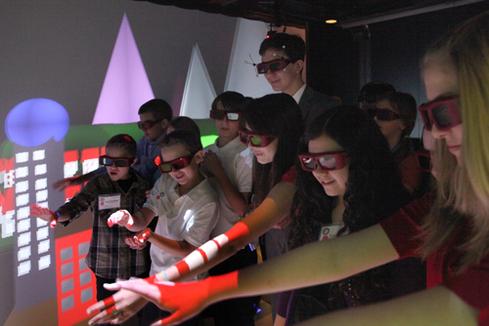Raytheon, No. 4 in the InformationWeek Elite 100 ranking, uses CAVEs -- computer-assisted virtual environments -- to boost collaboration among engineers and with customers.

A missile streaking toward you is a terrifying visual, but for Raytheon engineers it's a welcome sight.
Virtually speaking, of course.
Raytheon's engineering and manufacturing groups are working closely with its IT organization on stereoscopic 3D (S3D) and augmented-reality technologies to help Raytheon engineers collaborate with one another and with partners and suppliers on missile designs.
Engineers start the process with computer-aided design (CAD) product drawings rendered into 3D models placed onto S3D displays. The final destination for these models is state-of-the-art S3D screens that Raytheon calls CAVEs, or cave automatic virtual environments. ("Cave" itself stands for computer assisted virtual environment.)
[For more InformationWeek Elite 100 coverage and a complete listing of the top 100 companies, click here.]
CAVEs can be the size of a small theater or can be taken off-site via portable screens. Or, the CAVE experience could be as intimate as an engineer wearing 3D glasses sitting at an S3D-enabled workstation that's linked to a remote site. Whichever shape a CAVE takes, when engineers put on 3D eyewear and step into one, they become part of an augmented-reality world where they can see products in a three-dimensional space and share the view with others.
Before adopting S3D and augmented-reality technologies, Raytheon engineers would analyze CAD drawings by sitting together with laptops talking through design issues, a process that simply took too long. "With 3D visualizations, people spread out around the world get the same immersive view of a missile design or a simulated battle environment," says Anthony Jones, director of architecture and advanced technologies at Raytheon Missile Systems.
Figure 1:  Raytheon engineers and customers collaborate on products in a 3D space.
Raytheon engineers and customers collaborate on products in a 3D space.
In a typical meeting, engineers and partners collaborate within a CAVE on a videoconference. The emphasis at meetings isn't on having one group presenting to another, but rather on letting everyone explore the 3D models together. "They might as well be in the same room at that point," Jones says. "If there are language barriers among international partners and engineers, the 3D models and CAVEs become a common language."
Creating virtual missile prototypes is more cost-effective than building physical ones, with the added benefit of speeding up design and getting products to market faster.
"It's easy to look inside a 3D missile model to see if some wiring is too close to a part that gets hot and then adjust the design quickly," says Jones, adding that in the physical world you'd have to take a missile prototype apart to check on wiring, which is time-consuming.
In addition to improving teamwork internally, 3D models and CAVEs also have injected new life into customer presentations. Raytheon uses CAVEs to demo products by placing customers in a simulated battle environment, complete
Next Page
with S3D imagery and an augmented-reality backdrop of mountains or a desert.
This type of "you are there" experience can spark customers' creativity, Jones says. They might not know exactly what product they're looking for until they're thrown into a simulated 3D atmosphere.
For example, Raytheon recently showed a customer a naval missile in an S3D environment that simulated a battleship at sea. The experience brought out characteristics of the ship-based missile that the customer also wanted in a land-based missile. "That idea wasn't on their mind going into the demo," Jones says.
Raytheon has also used the technology to inspire middle school students, as part of the company's efforts to encourage STEM learning among the young.
Figure 2:  Raytheon brings school projects to 3D life for middle school
Raytheon brings school projects to 3D life for middle school
students in Tucson, Ariz.
Beyond designing virtual missile prototypes and demoing products, Raytheon used its 3D models, augmented reality, and CAVEs last year to design and test an entire missile factory based in Huntsville, Ala. The factory uses the latest robotics and computer-controlled tools and houses SM-3 missiles, a key component in the US government's missile defense plan.
By modeling the missile factory in a CAVE, Raytheon engineers detected early on that some equipment was set up too closely together to be safe, so they made adjustments before physically building the factory.
The two main challenges when deploying an S3D and augmented-reality system, Jones says, have been getting Raytheon's conventional 2D images up to 3D standards and investing in the physical space and screens needed for CAVEs. But the transition was worth it, he says, as engineers embrace S3D scenarios while the company saves money.
Raytheon estimates that visualization technologies have prevented potential design errors and saved a substantial number of engineering hours in manufacturing products. Money savings have come from eliminating cross-country trips between Raytheon and its suppliers, avoiding product mock-up and proof-of-design failures, passing design reviews and completing designs more quickly, and spotting early on potential mechanical defects that might not have been found without immersive S3D.
Raytheon's CAVEs are still a work in progress, though, says Jones, who looks forward to some of the next-generation 3D environments that won't require the eyewear now needed for CAVEs. He also hopes to use iPads and "smart" glasses such as Google Glass to enter S3D and AR scenarios.
But he's most enthusiastic about advances in portable virtual and augmented-reality gear expected to be made in the next five years. At Raytheon's Immersive Design Center, IT teams work with operations and engineering to test new technologies. One gadget Raytheon is looking at now is Oculus Rift, a still-in-development virtual reality headset (whose maker was recently acquired by Facebook) that's used for 3D gaming where the wearer interacts with objects and other players.
Says Jones: "We're excited to adapt gaming and consumer-driven technologies to our world."
IBM, Microsoft, Oracle, and SAP are fighting to become your in-memory technology provider. Do you really need the speed? Get the digital In-Memory Databases issue of InformationWeek today.
About the Author(s)
You May Also Like







